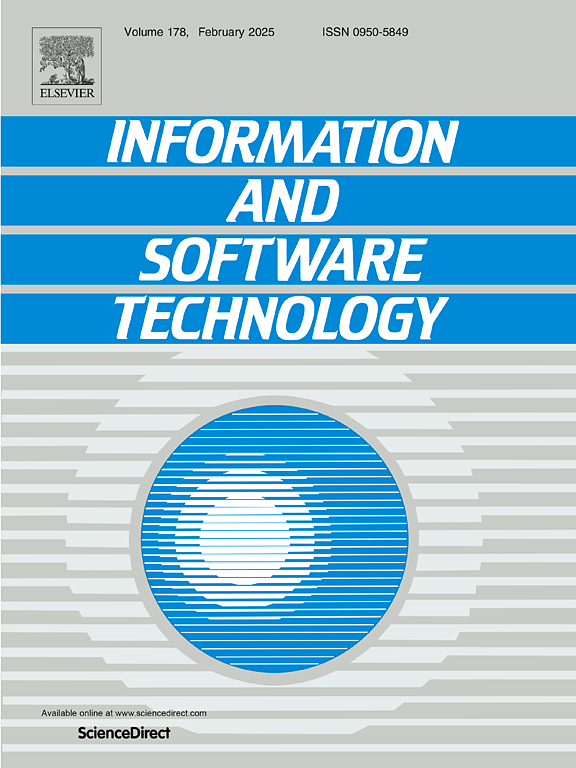A systematic mapping study on graph machine learning for static source code analysis
IF 4.3
2区 计算机科学
Q2 COMPUTER SCIENCE, INFORMATION SYSTEMS
引用次数: 0
Abstract
Context: In recent years, graph machine learning and particularly graph neural networks have seen successful and widespread applications in many fields, including static source code analysis. Such machine learning techniques enable learning on rich information networks capable of representing different relations and entities.
However, there have been no comprehensive studies investigating the use of graph machine learning for static source code analysis. There is no complete systematic picture of what techniques may be considered tried and tested, and where opportunities for future improvements can still be found.
Objective:
The main goal of this study is to provide a broad overview of the state of the art of static source code analysis using graph machine learning.
Methods:
A systematic mapping was performed covering 4499 studies, presenting a final selection of 323 primary studies.
Results:
Among the selected studies, seven major sub-domains were identified. The use and combinations of artefacts, different graph representations, different features, and different machine learning models used were collected and categorised.
Conclusions:
The use of graph learning, and in particular graph neural networks, has increased significantly since 2018. Although a wide variety of methods is used, across every dimension we investigated (artefacts, graphs, features, models), we found small sets of technologies which are used in the vast majority of studies. Future opportunities lie in exploring under-explored domains more thoroughly, exploring the use of additional artefacts alongside source code, and paying more attention to interpretability and explainability.
用于静态源代码分析的图机器学习系统映射研究
背景:近年来,图机器学习,特别是图神经网络在许多领域取得了成功和广泛的应用,包括静态源代码分析。这种机器学习技术能够在能够表示不同关系和实体的丰富信息网络上进行学习。然而,还没有全面的研究调查使用图机器学习静态源代码分析。对于哪些技术可以被认为是经过尝试和测试的,以及在哪些方面仍然可以找到未来改进的机会,没有一个完整的系统的描述。目的:本研究的主要目标是提供使用图机器学习的静态源代码分析技术的广泛概述。方法:对4499项研究进行了系统的制图,最终选择了323项主要研究。结果:在选择的研究中,确定了七个主要的子领域。收集和分类了人工制品的使用和组合、不同的图表示、不同的特征和使用的不同机器学习模型。结论:自2018年以来,图学习,特别是图神经网络的使用显著增加。尽管使用了各种各样的方法,在我们调查的每个维度(人工制品、图形、特征、模型)中,我们发现了在绝大多数研究中使用的一小部分技术。未来的机会在于更彻底地探索未被探索的领域,探索除了源代码之外的附加工件的使用,并更多地关注可解释性和可解释性。
本文章由计算机程序翻译,如有差异,请以英文原文为准。
求助全文
约1分钟内获得全文
求助全文
来源期刊

Information and Software Technology
工程技术-计算机:软件工程
CiteScore
9.10
自引率
7.70%
发文量
164
审稿时长
9.6 weeks
期刊介绍:
Information and Software Technology is the international archival journal focusing on research and experience that contributes to the improvement of software development practices. The journal''s scope includes methods and techniques to better engineer software and manage its development. Articles submitted for review should have a clear component of software engineering or address ways to improve the engineering and management of software development. Areas covered by the journal include:
• Software management, quality and metrics,
• Software processes,
• Software architecture, modelling, specification, design and programming
• Functional and non-functional software requirements
• Software testing and verification & validation
• Empirical studies of all aspects of engineering and managing software development
Short Communications is a new section dedicated to short papers addressing new ideas, controversial opinions, "Negative" results and much more. Read the Guide for authors for more information.
The journal encourages and welcomes submissions of systematic literature studies (reviews and maps) within the scope of the journal. Information and Software Technology is the premiere outlet for systematic literature studies in software engineering.
 求助内容:
求助内容: 应助结果提醒方式:
应助结果提醒方式:


